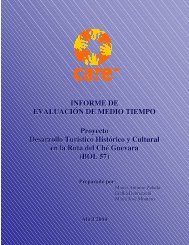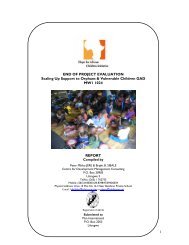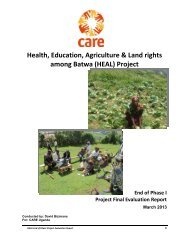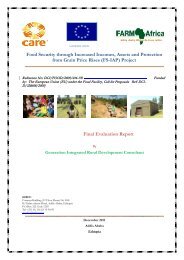IND 199 ECDE Baseline - CARE International's Electronic ...
IND 199 ECDE Baseline - CARE International's Electronic ...
IND 199 ECDE Baseline - CARE International's Electronic ...
- No tags were found...
Create successful ePaper yourself
Turn your PDF publications into a flip-book with our unique Google optimized e-Paper software.
lxiiibead with nylon wire” in intervention & intermediate AWCs and control AWCs , whereasdrawing a diamond in imitation could be completed by 5 percent or less children (Tables7.5A – 7.7A in Annexure -2).Hearing , language & concept development• More than half of the children achieved all the milestones except “recognizing 3 colours”, “singing two lines of song/folk poem” and “completing a sentence”. These milestoneswere achieved by less than 40 percent of children (Tables 7.8A – 7.10A in Annexure -2).Self help skills• Hardly 1 percent of children in intervention districts and less than 5 percent in controldistrict achieved each of the milestones under this component (Tables 7.11A inAnnexure -2).Social skills• Around 90 percent of children in intervention , intermediate and control AWCs “couldtell their name”, while around 80 percent in intervention district and 73 percent incontrol district “could tell their gender”.• “Playing with other children” and “understanding rules of game” were expressed by 2-3percent of children.• There was no difference by gender and caste of the child in achieving the milestonesunder this component (Tables 7.12A – 7.14A in Annexure -2).Overall scoring• Overall more than 90 percent of the children in intervention and control district havescored more than 50 percent of marks out of 44 in achievement of milestones. Childrenare better in overall scoring in control district (about one – third obtained more than75% marks out of 44) than in intervention AWCs (19%) and intermediate AWCs (16%),showing no gender differentials.• Children belonging to SC and OBC are marginally better in overall scoring than ST inintervention districts, whereas children belonging to SC/ST are marginally better thanOBC in control district (Table 7.1 and Table 7.2).Table 7.1: Distribution of children aged 3-3.5 years by quartiles on overall scoring onall milestones and gender(Percentage)Quartiles onoverall scoringon allmilestonesTotal Janjgir and korbaControl district (Raigarh)Intervention AWCs Intermediate AWCs Control AWCsMale Female Total Male Female Total Male Female Total(n=) 221 221 442 219 221 440 218 248 466< 25% 2.3 0.5 1.4 0 1.4 0.7 0.5 2.4 1.525.1 -50% 14.5 11.8 13.1 12.8 10.9 11.8 3.7 6 4.950.1 -75% 64.3 68.8 66.5 69.9 72.9 71.4 64.7 58.1 61.2> 75% 19 19 19 17.4 14.9 16.1 31.2 33.5 32.4Table 7.2: Distribution of children aged 3-3.5 years by quartiles on overall scoring onall milestones and caste(Percentage)Quartiles onoverall scoringon all milestonesTotal Janjgir and korbaControl district(Raigarh)Intervention AWCs Intermediate AWCs Control AWCs<strong>Baseline</strong> Study Of Early Childhood Care And Development Project In ChattisgarhApril,2012
















